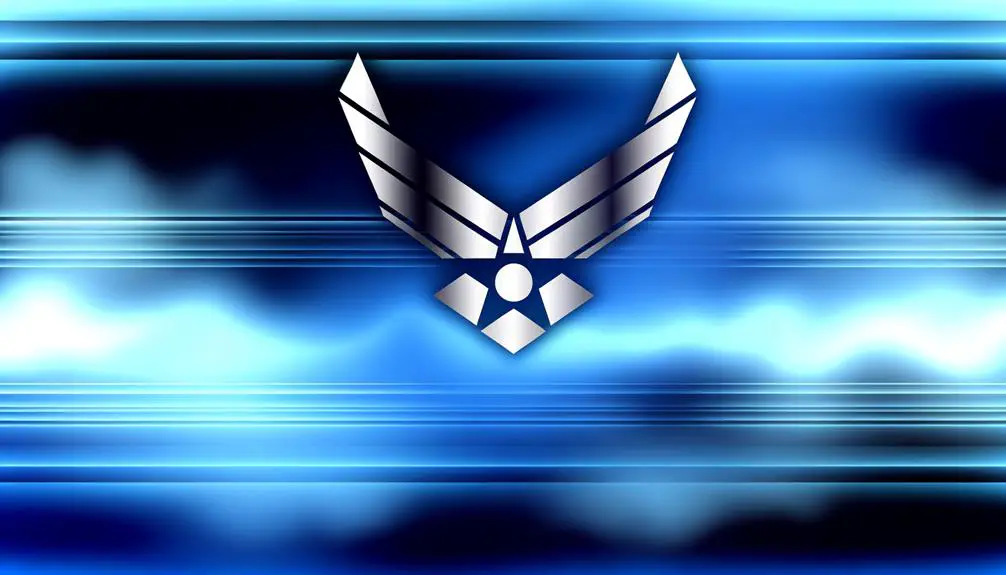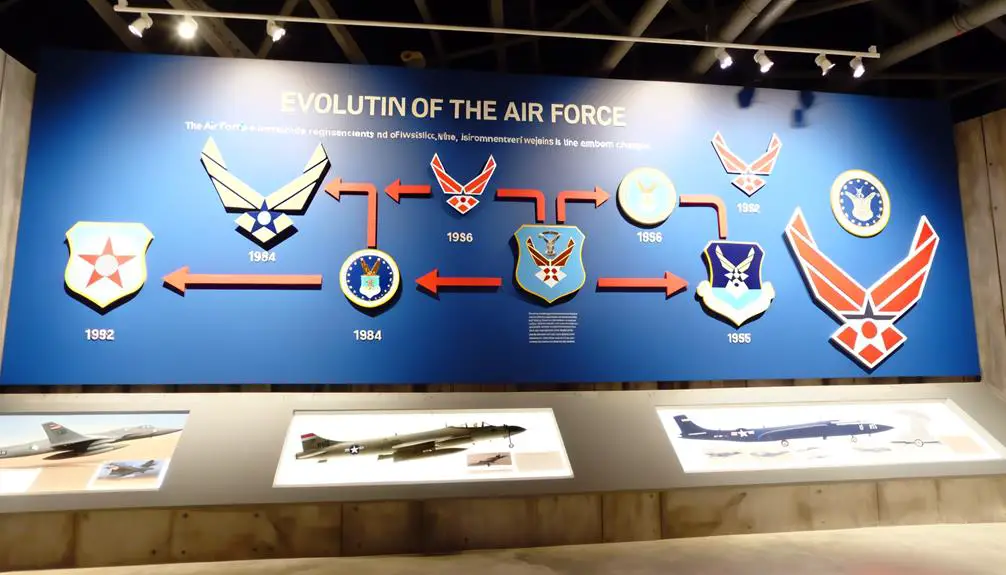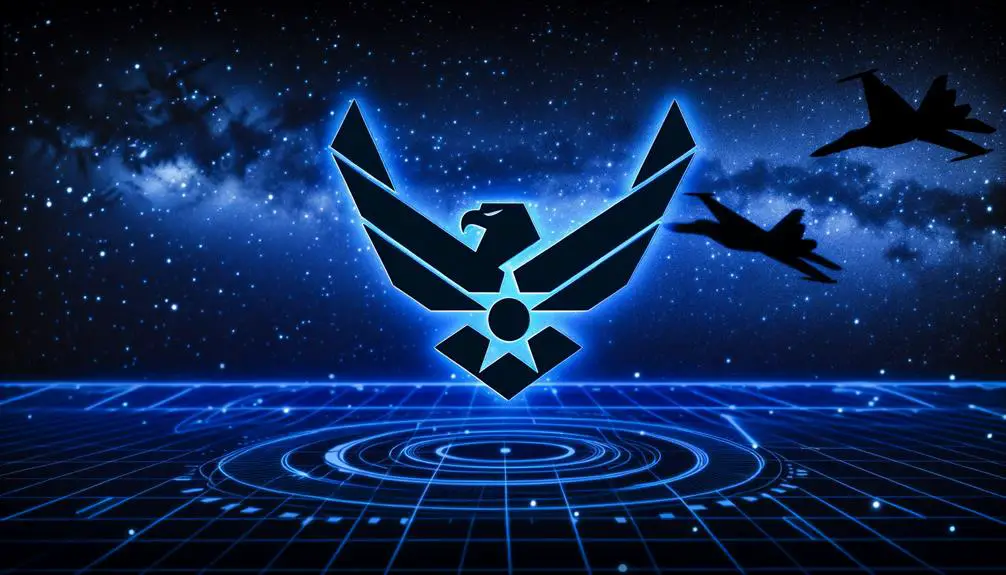What Is the Meaning of the Air Force Symbol?
The Air Force Symbol captures the core values and strategic vision of the United States Air Force. Its design, featuring stylized wings and a central star, symbolizes strength, agility, and excellence.
The blue and white color scheme represents purity, vigilance, and the boundless sky. These elements collectively reflect the Air Force's dedication to integrity, service, and excellence.
The eagle signifies vigilance, the star represents the high frontier of space, and the wings denote advanced aerospace capabilities. This emblem underscores the Air Force's commitment to global vigilance, innovation, and the protection of national interests.
Learn more about the symbol's deeper meanings and historical evolution.

Key Takeaways
- The wings symbolize strength, agility, precision, and advanced technology.
- The star signifies excellence and high standards.
- The color scheme of blue and white represents purity, vigilance, and the boundless sky.
- The eagle represents strength, agility, and vigilance.
- The stylized wings indicate the swiftness and power of air and space capabilities.
History of the Air Force Symbol

The history of the Air Force Symbol is deeply rooted in the evolution of military aviation and reflects the core values and heritage of the United States Air Force.
Initially, the emblem evolved from early aviation insignias used during World War I, symbolizing the burgeoning aeronautical capabilities of the era.
Post-World War II, as the Air Force became an independent service in 1947, there was a pronounced shift towards creating a unique identity that encapsulated its mission and ethos.
The symbol underwent multiple iterations, each embodying the advancements in technology and strategic doctrines.
Throughout its history, the Air Force Symbol has served not just as a visual representation, but as a reflection of the perseverance, innovation, and excellence of the Airmen.
Design Elements

In analyzing the design elements of the Air Force Symbol, one must consider the intricate interplay of shapes, colors, and symbolism that collectively convey the identity and values of the United States Air Force.
The emblem's structure consists of a stylized pair of wings and a star, with the wings embodying both strength and agility. Their angular design suggests precision and advanced technology. The star, centrally positioned, signifies excellence and high standards.
The color scheme, primarily blue and white, underscores the Air Force's emphasis on purity, vigilance, and the boundless sky. Each element is meticulously chosen to reflect the core attributes of the Air Force, ensuring that the symbol resonates with its personnel and the broader public.
Symbolic Meanings

As one explores the symbolic meanings of the Air Force Symbol, it becomes evident that each design element is imbued with profound significance, carefully crafted to embody the core principles and ethos of the United States Air Force. The symbol's structure is not merely aesthetic; it encapsulates the historical lineage, technological prowess, and forward-thinking vision of the Air Force.
Key elements include:
- The Eagle: Represents the strength, agility, and vigilance of the force.
- The Star: Symbolizes space as the high frontier, reflecting the Air Force's future-focused mission.
- The Stylized Wings: Indicate the swiftness and power of air and space capabilities.
These elements together create a visual narrative that reinforces the Air Force's dedication to excellence and innovation.
Core Values Represented

Embodying the essence of integrity, service, and excellence, the Air Force Symbol serves as a powerful reminder of the core values that guide every member of the United States Air Force.
The symbol's design captures the fundamental tenets of integrity first, service before self, and excellence in all we do. The upward-reaching wings suggest the pursuit of higher standards and aspirations. The star, central to the emblem, signifies the importance of core values in providing a steady moral compass.
The surrounding sphere represents global vigilance and a commitment to protecting freedom worldwide. Through these elements, the symbol encapsulates the principles that uphold the Air Force's mission and ethos, reinforcing its dedication to ethical conduct, duty, and superior performance.
Modern-Day Significance

The Air Force Symbol continues to hold profound relevance in contemporary contexts, symbolizing not only the enduring values of the institution but also its adaptability and resilience in an ever-evolving global landscape. This emblem serves as a visual representation of the Air Force's commitment to innovation, excellence, and global vigilance.
In modern-day applications, the symbol underscores several key aspects:
- Technological Advancement: Reflecting the Air Force's pioneering role in aerospace and cyber capabilities.
- Global Presence: Demonstrating the strategic reach and influence of the Air Force worldwide.
- Unified Force: Emphasizing teamwork, cohesion, and the integration of diverse talents and resources.
These elements collectively affirm the Air Force's ongoing mission to protect national interests and promote global stability.
Conclusion
The Air Force symbol, with its intricate design elements and historical evolution, serves as a visual representation of the core values and enduring spirit of the United States Air Force.
Each component—from the wings to the star—encapsulates a narrative of honor, duty, and innovation.
This emblem not only honors the past but also inspires future generations, embodying a commitment to excellence, integrity, and service.
It stands as a beacon, guiding airmen in their mission to protect and serve.






